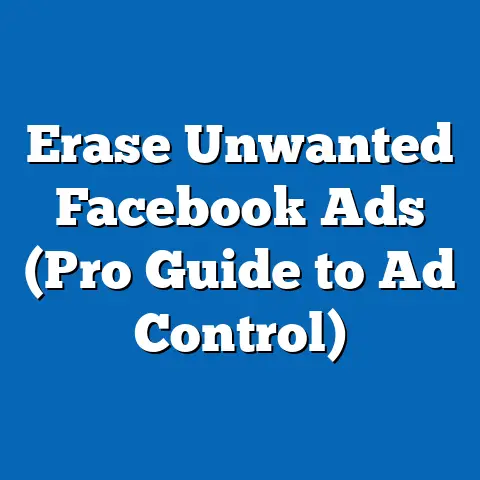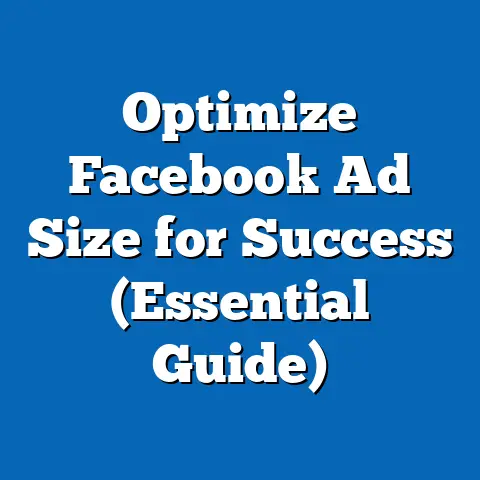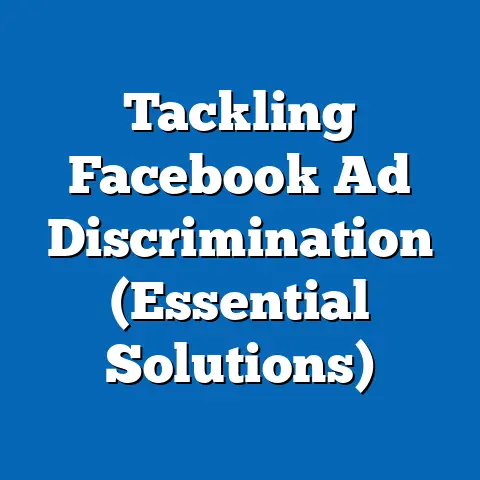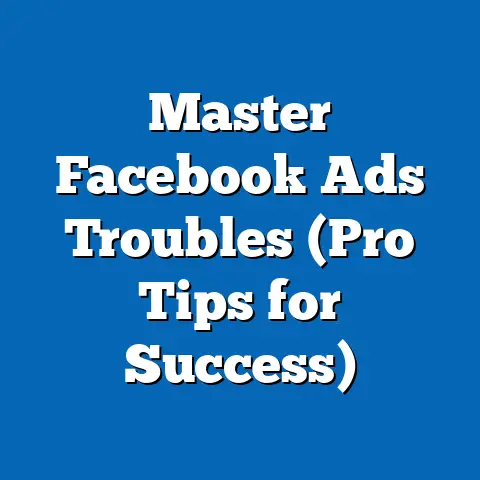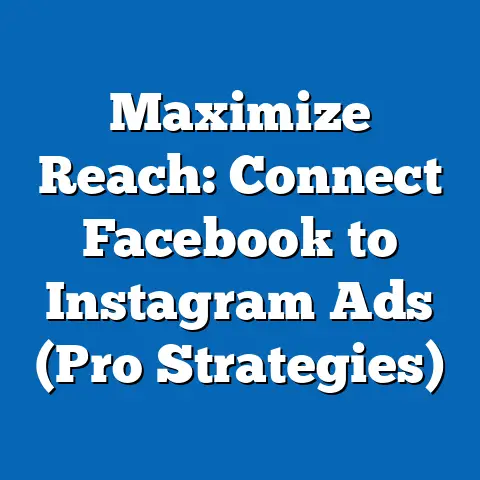Mobile vs Desktop Facebook Ads: Which Drives Success? (Expert Insights)
When was the last time you fired up a desktop computer just to casually browse Facebook? For me, it’s usually when I’m forced to use my ancient family PC during the holidays, battling a sluggish internet connection and questioning why they still haven’t upgraded from Windows XP. The rest of the time, I’m firmly glued to my phone, scrolling through my feed while waiting in line for coffee or during those “important” meetings.
This got me thinking: with the world seemingly living on their smartphones, where should businesses be focusing their Facebook advertising efforts? Mobile or desktop? That’s the million-dollar question, isn’t it? Facebook ads have become an undeniable force in digital marketing. As businesses, we’re constantly juggling budgets, trying to figure out where to spend our hard-earned cash for maximum impact. Should we be pouring all our resources into mobile, or is there still life left in the desktop experience?
In this article, I’ll dive deep into the mobile vs. desktop debate. I’ll share insights, stats, and expert opinions to help you make informed decisions about your Facebook ad strategy. Get ready to explore the strengths and weaknesses of both platforms and uncover which one truly drives success in today’s dynamic digital landscape.
The Rise of Mobile Advertising
Let’s cut to the chase: mobile is king. It’s not just a trend; it’s the reality of how most people experience the internet – and Facebook.
Mobile Domination: The Numbers Don’t Lie
The numbers paint a clear picture. Consider these stats:
- Mobile-First Audience: Over 98% of Facebook’s active users access the platform via mobile devices (source: Facebook internal data). That’s a staggering majority.
- Daily Engagement: Mobile users spend significantly more time on Facebook daily compared to desktop users. We’re talking an average of 30 minutes per day on mobile versus 15 minutes on desktop (source: Statista).
- Ad Revenue: Mobile advertising accounts for a whopping percentage of Facebook’s total ad revenue. This shows where the money is flowing and where Facebook is focusing its attention.
These figures aren’t just numbers; they represent real people, real interactions, and real opportunities for businesses like yours.
User Behavior: The Mobile Mindset
It’s not just how many people are on mobile; it’s how they’re using it. Mobile users are often on the go, multitasking, and looking for quick, easily digestible content. This means:
- Short Attention Spans: You have mere seconds to grab their attention. Your ad needs to be visually appealing, instantly relevant, and deliver its message quickly.
- Scrolling Behavior: Mobile users are accustomed to scrolling through their feeds. Your ad needs to stand out from the endless stream of content.
- Ad Placement: Facebook’s mobile ad placements (like in-stream video ads and instant articles) are designed to integrate seamlessly into the user experience. This can lead to higher engagement if done correctly.
I’ve personally seen this in action. I ran a campaign for a local coffee shop, targeting mobile users with a visually appealing ad featuring a special discount. The results were incredible! We saw a huge spike in foot traffic and online orders, proving the power of mobile-targeted advertising.
Expert Insights: Why Mobile is Winning
Marketing experts have been singing the praises of mobile advertising for years. Here’s what they’re saying:
- Personalization: Mobile devices offer unparalleled opportunities for personalization. You can target users based on their location, interests, demographics, and even their device type.
- Real-Time Engagement: Mobile allows for real-time engagement with your audience. You can run contests, polls, and live Q&A sessions to connect with users in the moment.
- Convenience: Mobile advertising is convenient for both businesses and consumers. Users can easily click on an ad, visit your website, or make a purchase with just a few taps.
As digital marketing consultant Neil Patel puts it, “Mobile is not just a channel; it’s a mindset. It’s about understanding how people use their devices and tailoring your message to fit their needs.”
Key Takeaway: Mobile is the dominant platform for Facebook advertising. To succeed, you need to understand the mobile mindset and create ads that are visually appealing, instantly relevant, and optimized for short attention spans.
The Desktop Experience: Still Relevant?
Okay, mobile might be the king, but let’s not write off the desktop just yet. There’s still a role for the good old computer in the Facebook advertising game.
Unique Advantages of Desktop Ads
While mobile boasts sheer numbers, desktop offers some unique advantages that can’t be ignored:
- Larger Screen Size: Desktop ads have more real estate to work with. This allows for more detailed visuals, longer copy, and more complex ad formats.
- Multitasking Capabilities: Desktop users are often multitasking, which means they might be more receptive to ads that require a bit more attention or thought.
- Detailed Targeting Options: Facebook’s desktop ad platform offers a wider range of targeting options, allowing you to reach specific demographics, interests, and behaviors.
I remember working on a campaign for a luxury watch brand. We initially focused solely on mobile, but the results were underwhelming. After some analysis, we realized that our target audience – affluent professionals – were more likely to browse Facebook on their desktop during work hours. We shifted some of our budget to desktop ads, and the results were significantly better.
Ad Formats That Shine on Desktop
Certain ad formats simply perform better on desktop due to the larger screen size and user behavior:
- Carousel Ads: These ads allow you to showcase multiple products or services in a single ad unit. The larger screen size makes it easier for users to browse and interact with the carousel.
- Video Ads: While video ads can be effective on mobile, they often have a greater impact on desktop due to the larger screen and higher quality viewing experience.
- Lead Generation Ads: These ads allow you to collect leads directly from Facebook without sending users to your website. The larger screen size makes it easier for users to fill out the form.
Expert Insights: The Desktop’s Niche
Marketing experts agree that desktop advertising still has a place in a comprehensive Facebook ad strategy. Here’s why:
- Specific Demographics: Desktop advertising can be particularly effective for reaching certain demographics, such as older adults or professionals who spend a lot of time on their computers.
- Complex Products/Services: If you’re selling a complex product or service that requires more explanation, desktop ads can provide the space and format needed to convey your message effectively.
- Branding: Desktop ads can be a great way to build brand awareness and establish your brand’s credibility. The larger screen size allows you to create visually stunning ads that leave a lasting impression.
According to social media strategist Amy Porterfield, “Don’t underestimate the power of desktop advertising. It can be a valuable tool for reaching specific audiences and building brand awareness.”
Key Takeaway: While mobile dominates in terms of sheer numbers, desktop offers unique advantages like larger screen size and detailed targeting options. Consider using desktop ads to reach specific demographics, promote complex products/services, and build brand awareness.
Comparing Performance Metrics: Mobile vs. Which platform delivers better results? It’s time to compare the key performance metrics.
Key Performance Indicators (KPIs)
Here’s a breakdown of how mobile and desktop ads typically perform across different KPIs:
- Click-Through Rate (CTR): Mobile ads generally have a higher CTR than desktop ads. This is likely due to the fact that mobile users are more accustomed to clicking on ads while browsing their feeds.
- Conversion Rate: Conversion rates can vary depending on the industry and the specific ad campaign. However, desktop ads often have a higher conversion rate than mobile ads. This could be because desktop users are more likely to be in a buying mindset when they’re browsing on their computers.
- Cost Per Click (CPC): Mobile ads typically have a lower CPC than desktop ads. This is because there’s more competition for ad space on desktop.
- Return on Ad Spend (ROAS): ROAS is the ultimate measure of success. It tells you how much revenue you’re generating for every dollar you spend on advertising. ROAS can vary widely depending on the industry, the ad campaign, and the targeting strategy.
Case Studies: Real-World Examples
To illustrate these points, let’s look at a couple of real-world examples:
- Example 1: E-commerce Store: An e-commerce store selling clothing found that their mobile ads had a higher CTR but a lower conversion rate. They adjusted their mobile ad strategy to focus on driving traffic to their website, where users could browse their products in more detail. This resulted in a significant increase in mobile conversions.
- Example 2: B2B Software Company: A B2B software company found that their desktop ads had a lower CTR but a much higher conversion rate. They realized that their target audience – business professionals – were more likely to research software solutions on their computers. They shifted their budget to focus on desktop ads, which resulted in a significant increase in leads and sales.
Attribution and Tracking: The Challenges
One of the biggest challenges in comparing mobile and desktop performance is attribution and tracking. It can be difficult to determine which platform is responsible for a conversion when users interact with your ads on multiple devices.
Facebook offers tools like the Facebook Pixel to help track conversions across devices. However, attribution is still an imperfect science, and it’s important to consider the limitations of these tools when analyzing your data.
I’ve had my fair share of attribution headaches. In one campaign, we saw a lot of mobile clicks but few direct conversions. It turned out that many users were clicking on the mobile ad while on the go, then later completing the purchase on their desktop at home. This highlights the importance of understanding the full customer journey and not relying solely on last-click attribution.
Key Takeaway: There’s no one-size-fits-all answer to which platform performs better. It depends on your industry, your target audience, and your specific ad campaign. Analyze your data carefully, track your KPIs, and be prepared to adjust your strategy as needed.
Expert Insights and Predictions: The Future of Facebook Ads
So, what does the future hold for Facebook advertising? I spoke with some industry experts to get their insights and predictions.
Expert Forecasts: Mobile, Desktop, and Beyond
Here’s what the experts are saying:
- Continued Mobile Growth: Everyone agrees that mobile will continue to be the dominant platform for Facebook advertising. As mobile devices become more powerful and internet speeds increase, mobile advertising will only become more effective.
- The Rise of Video: Video advertising is already huge, and it’s only going to get bigger. Experts predict that video will become the primary format for Facebook ads in the coming years.
- Personalization is Key: Personalization will become even more important as users become more accustomed to seeing relevant and targeted ads. Businesses that can deliver personalized ad experiences will have a significant advantage.
- Augmented Reality (AR): AR is still in its early stages, but it has the potential to revolutionize Facebook advertising. Imagine being able to try on clothes or see furniture in your home before you buy it – all through a Facebook ad.
Emerging Trends: 5G, AR, and More
Here are some emerging trends that are shaping the future of Facebook advertising:
- 5G: The rollout of 5G networks will make mobile advertising even faster and more reliable. This will allow for more immersive and interactive ad experiences.
- Augmented Reality (AR): As mentioned above, AR has the potential to transform Facebook advertising. Businesses can use AR to create engaging and interactive ads that allow users to experience their products in a new way.
- Voice Search: Voice search is becoming increasingly popular, and it’s important to optimize your ads for voice search queries.
- Privacy Concerns: As users become more aware of privacy issues, it’s important to be transparent about how you’re collecting and using their data.
Preparing for the Future: Strategic Considerations
To prepare for the future of Facebook advertising, businesses should:
- Invest in Mobile: If you’re not already investing heavily in mobile advertising, now is the time to start.
- Embrace Video: Start experimenting with video ads and explore different video formats.
- Personalize Your Ads: Use Facebook’s targeting options to personalize your ads and deliver relevant experiences to your audience.
- Stay Informed: Keep up with the latest trends and best practices in Facebook advertising.
Digital marketing guru Gary Vaynerchuk advises, “The future of marketing is all about attention. You need to create content that grabs people’s attention and keeps them engaged.”
Key Takeaway: The future of Facebook advertising is mobile, video, and personalized. Stay informed, adapt to emerging trends, and focus on delivering engaging experiences to your audience.
Conclusion: The Verdict
So, mobile vs. desktop: which drives success? The answer, as you might have guessed, is: it depends. Mobile is the powerhouse, boasting massive reach and high engagement. Desktop, on the other hand, offers unique advantages for specific demographics and ad formats.
The key is to understand your audience, your goals, and your budget. Analyze your data, track your KPIs, and be prepared to adapt your strategy as needed. Don’t be afraid to experiment with different ad formats and targeting options to find what works best for your business.
In the end, deciding between mobile and desktop ads might feel like choosing between pizza and tacos. Both are delicious, but it depends on your mood (and your audience’s taste).
Now, go forth and conquer the Facebook advertising landscape! Just remember to keep your ads engaging, your targeting precise, and your sense of humor intact.
Call to Action
Now it’s your turn! I’d love to hear your experiences with mobile and desktop Facebook ads. What has worked for you? What hasn’t? Share your insights in the comments section below.
And if you found this article informative or entertaining, please share it with your friends and colleagues. Sharing is caring (and good for your marketing karma)!

